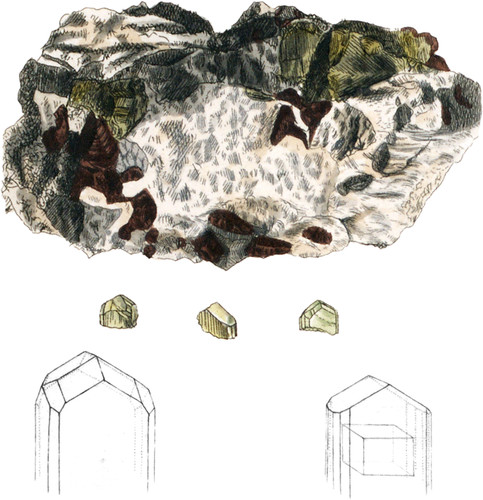 Enlarge
Enlarge
Exotic Mineralogy
Chrysoberill
- Syn.
- Cymophane, Haüy, Tabl. 30. Traité 2. 491.
- Chrysoberill, Emmerl. 1. 19.
- Chrysoberil, Kirw. 1. 261.
We are obliged to the President of the Geological Society for the use of this fine specimen; it is from Connecticut. The crystals are drawn from specimens in the possession of the Count de Bournon, to whom we expect the scientific world will soon be obliged for some account of his valuable collection. While we may regret our inability to represent these things in their natural splendour, we may rejoice to have been allowed to give that help which must, more or less, aid instruction. Figures in all cases help language, and give a more perfect idea where the thing itself is seldom seen, and very often elucidate, by geometrical magnified sketches, the specimen that might otherwise escape very acute adepts, who often find such figures necessary to assist each other.
The crystals in the matrix are so placed, that very few natural faces remain; the fracture, however, is more distinct. Their green colour is partly relieved by grey Quartz, in a vein, of which they form a part, mingled with Garnets. The Garnets, with the grey Quartz, and a little of the Chrysoberill, are also dispersed among the white Feldspar, and the Quartz is in some parts coated with Asbestus.
Chrysoberill is generally of a bright yellow, or yellowish green colour, in many crystals a remarkable opalescent blue glare is visible within, either through the narrower faces of the prism, or in the direction of their axis, but if viewed in other directions they are transparent. The primitive crystal is a rectangular prism, parallel to the sides of which, fractures may sometimes be found. It is harder than Spinnell, brittle, fragments conchoidal, sharp-edged, transparent. Infusible without addition. Spec. Grav. 3.600 to 3.7961.
| Alumina | 71.5 |
| Silica | 18.0 |
| Lime | 6.0 |
| Oxide of Iron | 1.5 |
| Loss | 3.0 |
| 100.0 |
Known in common as Opalescent or Oriental Chrysolite. Sometimes used in rings: rare among the Jewellers.
Jameson.

